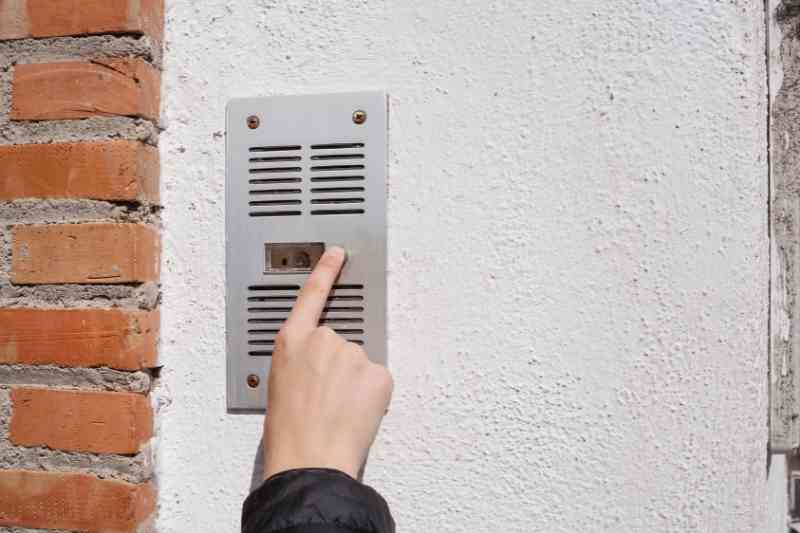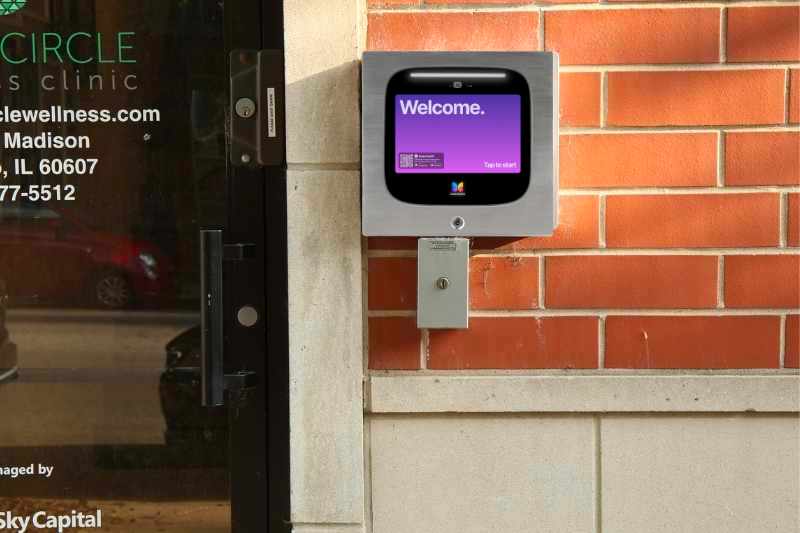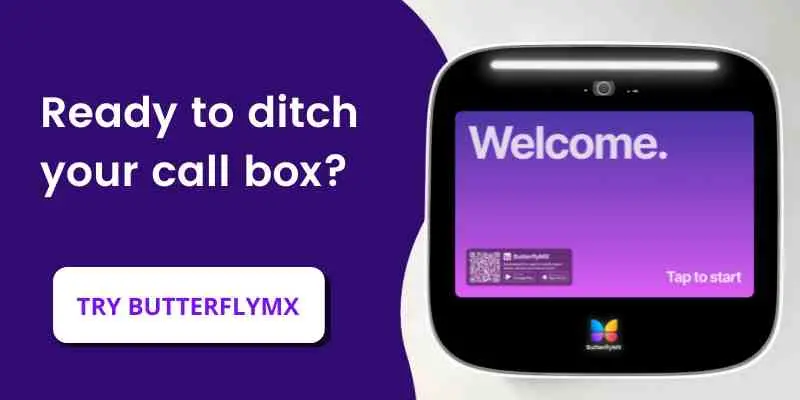Key takeaways
- An intercom call box is a system that allows visitors to request access from a tenant.
- Tenants can let visitors in using either a substation installed in their apartment unit or a cell phone hooked into the call box system.
- Types of call boxes for sale include cellular, radio, wireless, and video call boxes.
- While intercom boxes are convenient, they’re outdated. Some of their drawbacks include a lack of mobile apps, integrations, and video functionality.

Access control systems, including an intercom call box, come in various shapes and sizes. Call boxes for apartments and commercial properties have been in use for years.
However, are call boxes the best access control solution for your property? Whether you’re developing a new building or plan to retrofit a building entry system into your existing property, we’ll cover everything you need to know about intercom call boxes.
In this guide, we cover:
- What is an intercom call box?
- How an intercom call box works
- Types of intercom call box systems
- 5 intercom call box problems
- The best intercom call box alternative
What is an intercom call box?
An intercom call box is a building entry system that allows someone at a property entrance to request access from a tenant or resident.
Intercom call boxes consist of three components:
- Call box: Located at the property’s entry, the call box is the device visitors will use to call a tenant and request access.
- Substations: Often hardwired into each unit, substations are the devices tenants use to grant access and speak with visitors.
- Door strike: Connected to the door call box, the door strike receives a signal to unlock the door and let the visitor inside.
These access control systems have been used for years because they enhance security and safety. Plus, they provide a level of convenience for tenants. The ability to receive access requests and grant them without ever having to leave the apartment unit benefits everyone involved.
Where are intercom call boxes used?
Access control is an essential part of any property that expects guests. Intercom call boxes can be found in several different buildings.
You can find intercom call boxes installed at:
- Apartments
- Gated communities
- Offices
- Commercial buildings
- Mixed-use properties
- Student housing
Watch how ButterflyMX works:
How an intercom call box works
A call box prompts visitors to contact a tenant using the directory provided at the entrance. Visitors enter a code or press a button to call the tenant they’re visiting.
Then, the call box sends a signal to the respective substation. Most call boxes are wired, but some may send signals wirelessly. From there, the resident may speak with the visitor requesting access.
After speaking, access can be granted using the substation. Once the ‘door open’ button is pressed, the substation sends a signal to the intercom box, releasing the door strike for the visitor to enter.
How do I let someone in with a call box?
You can let someone in with a call box by pressing a button on your substation. Or, if you’ve paired your call box with your cell phone, you can press ‘9’ on your phone’s keypad to let them in.

Types of intercom call box systems
When choosing an intercom box system, you have several options.
There are five main types of intercom call boxes:
- Two-way radio intercom call box
- IP Intercom call box
- Cellular intercom call box
- Wireless intercom call box
- Video intercom call box
Two-way radio intercom call box
When you think of a call box intercom, you may think of a two-way radio intercom. These systems were some of the first wireless call boxes available. Sometimes, they may connect to the door strike, allowing remote access.
Two-way radio intercoms allow the unit occupant and the visitor to talk while pressing a button. It operates like a pair of radios, allowing only one person to speak at a time.
Two-way radios might also power emergency call boxes, which are located on college campuses or on the sides of highways.
These devices have a very limited operating range. So, they aren’t a good fit for larger properties. Additionally, two-way radio intercoms lack many modern features that other intercom boxes offer.
IP intercom call box
These intercom call boxes use the internet to pass along communications between parties. IP stands for Internet Protocol, which are rules established to determine how data is sent via the Internet.
An IP call box is often connected directly to the Internet using an ethernet cable. However, wireless IP intercoms, which allow connections over WiFi, have emerged as popular choices.
With the help of WiFi, you can establish more reliable connections over far distances, which comes with a variety of benefits. For example, you would no longer have to wire a residential gate call box to every substation on your property — you could wirelessly establish that connection!
However, a risk you must consider when using WiFi connectivity is losing a signal, which can render the system inoperable.

Cellular intercom call box
Cellular networks can communicate much further than two-way radios between visitors and units. Cellular call boxes now work with landlines and smartphones, allowing tenants to grant access from almost anywhere.
A cellular call box is a great choice because of the greater distance it reaches. However, it requires its cellular service plan to make calls, greatly increasing operating costs. Therefore, it’s something you should consider heavily.
Wireless intercom call box
Wireless call box intercoms are a great way to cut down on installation costs because you won’t have to run wires throughout the entire property.
A wireless call box can use any of the following to operate:
- Radio frequencies
- WiFi
- Cellular networks
Video intercom call box
Before video, call boxes only allowed people to speak to each other. There was no way of seeing who was at the entrance, so people could buzz someone in without confirming their identity.
Now, video intercoms rectify that problem by showing the visitor who’s requesting access. Then, the tenant may grant or deny access. In addition to seeing the visitor at the door, the video intercom may take a time-stamped picture of their entry.
While not all video call boxes are perfect, they provide greater security than other door entry systems.
5 intercom call box problems
Call boxes have been used for decades, meaning their problems have long been tolerated.
The five issues with intercom call boxes are:
- Lack of a mobile app
- No cloud-based software
- Unable to integrate with other systems
- No video features
- Installation difficulties and costs
1. Lack of a mobile app
Cellular call boxes let tenants open the door with their phones, but the call is always a phone call. Usually, a tenant must answer the call and press ‘9’ on their phone to unlock the door.
However, a modern building entry solution should include a mobile app. That way, tenants can press a button to grant access to themselves and visitors — in addition to adding other convenient mobile features, like two-way calls with video enabled.

2. No cloud-based software
Traditional call boxes store data onsite. This means a staff member or technician must manually update the call box, which severely inconveniences staff and adds additional costs.
In contrast, a cloud-based call box stores all the data off-site in the cloud. Any update can be made from a mobile app or desktop. There is no need to call a technician to schedule maintenance; staff members can still manage the system remotely. This reduces operating costs and increases staff efficiency.
3. Unable to integrate with other systems
Your traditional call box won’t integrate with other systems on your property. For example, if you want to control access to the gym, you’ll need a separate system from the intercom call box. Additionally, call box intercoms usually don’t integrate with other proptech, like property management software and smart locks.
Choose a building entry system that works for every aspect of your property to avoid these hassles and wasted resources. It’s better for your staff and tenants.
4. No video features
Most intercom boxes don’t have a video feature. So, a resident would have to grant access based on the visitor’s voice alone, which can pose serious safety concerns for your property.
A video intercom adds additional safety and security to a property. A camera feed is sent directly to the tenant’s substation, where they can see who requests access to the building.
Furthermore, your video intercom will store a time-stamped photo of the visitor entering the building. This is an additional security measure that you can access later.
5. Installation difficulties and costs
Finally, a major issue with call box intercoms is the need to run wiring throughout the entire building. While some call boxes are wireless, the majority require an extensive installation project. As a result, installation costs are high.
The better option is a wireless intercom that requires only a few wired connections. That way, installation costs are a fraction of what a traditional system would run.

The best intercom call box alternative
Intercom call boxes are no longer the best solution for property access control. A video intercom system is a modern and forward-thinking choice.
Video intercoms offer more than intercom call boxes, including:
- Video functionality: Instead of just audio communication, residents can see who they’re speaking to, giving them peace of mind when granting access.
- Mobile app: Receiving access requests from the mobile phone app can reduce expensive in-unit hardware and wiring throughout the building. Tenants and staff can easily grant access from anywhere.
- Cloud-based software: A cloud-based access control system doesn’t need manual updating. All the data is stored in the cloud, which you can access and adjust from a mobile app or desktop. You can easily remove and input residents or tenants when necessary. There is no longer a need to schedule an appointment with a technician or have staff manually update the system.
- Wireless: A wireless video intercom doesn’t need wiring throughout the entire building. This speeds up installation and lowers costs. The only wiring your video intercom will need is the power, internet, and door strike connections.
- Integrations: Video intercom systems are smart enough to work with other technology, such as keypads and smart locks. That means your video intercom will integrate seamlessly with technologies controlling access to other spaces.
Why choose ButterflyMX
ButterflyMX takes on the role of an intercom call box but improves the experience. Staff members can save time by accessing the ButterflyMX cloud-based dashboard to update resident data and property access permissions whenever needed. Furthermore, staff can easily set up PIN codes for each mail carrier to prevent delivery issues.
Tenants will love how ButterflyMX eliminates missed visitors and stolen packages. They can send recurring or single-use Visitor Passes to planned visitors for easy access.
Delivery Passes make it easy for residents to ensure access to one-time delivery couriers, such as Amazon and Doordash drivers. Best of all, residents don’t have to be home when deliveries are made or walk to the lobby to let in a guest.
These features and many more are why ButterflyMX is installed in over 15,000 buildings and one million apartments.






